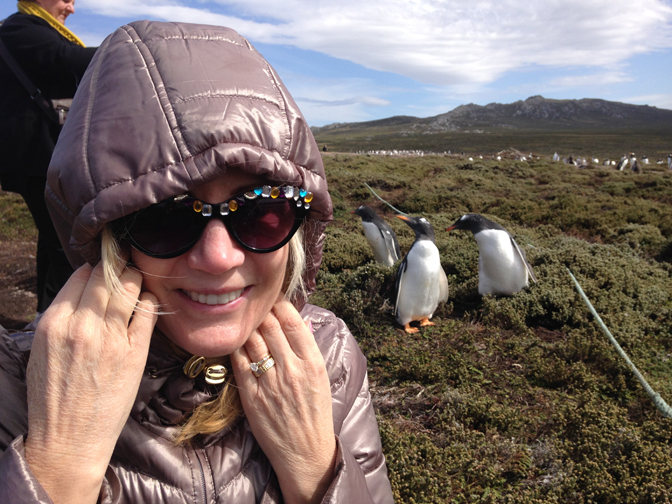There’s nothing like Crystal Cruises, especially when you’re visiting Antarctica.
We recently sailed on the Crystal Serenity, where we had the opportunity to visit the Falkland Islands — and the furry flightless birds that call this area home.
We booked a shore excursion through Crystal Cruises and we knew we were in for a treat. Our tender took us to Port Stanley, the Falklands capital, where there were Land Rovers waiting to bring us to Murrell Farm. We spent a half-hour in these vehicles — over rough terrain — until we came at last to the area where hundreds of penguins awaited us. Thank goodness we had packed parkas. The weather was cold and the wind was fierce.
We were taken to see Gentoo penguins, which thrive on Murrell Farm’s 10,000 acres. The operators use skilled sheepdogs and quad bikes to work the land. The farm produces its own bread and butter and still uses hand-cut peat to heat the house.
Travelers can walk fairly close to the penguins, but there is a definite line that people cannot cross, in order to give the penguins protection and privacy. That, however, did not stop some of these charismatic, waddling birds from waking up from their naps and crossing the line over to us. We spent an hour at this site, marveling at the spectacle of the penguins coming right up to us and basically saying, “Hello.” They were absolutely adorable as they fluffed out their feathers, and displayed their orange feet.
“Gentoo penguins are very prevalent in this part of the world,” said Michael DiSpezio, a marine biologist from Falmouth, Massachusetts, who was a guest enrichment lecturer on our Crystal Cruise. DiSpezio has written some 100 science textbooks and offered us fascinating insights into all-things-penguins and, for that matter, all-things-geography, during the course of our Antarctic cruise. (Besides lecturing on scores of cruises, he has hosted more than three dozen programs on the National Geographic Channel.)
“Penguins are flightless birds that, through evolution, have lost their ability to fly through the air, but do fly through water by beating their wings as they propel themselves through the water, like other Antarctic creatures. They live in groups called rookeries and have a layer of insulation called blubber,” he said.
The long-tailed Gentoo penguin is most closely associated with the Adélie penguin and the Chinstrap penguin.
DiSpezio noted that in the past, Adelie penguins were most commonly found on the Antarctic Peninsula, but now the entire area is more common to the Chinstrap species because of warming temperatures. “This is the evidence,” he said, “which scientists use to support their views of global warming…. There’s definitely been a shift in the population.”
While we were in the Antarctic in February, we learned that temperatures back on the East Coast were in the 70s — no doubt more evidence of global warming. Later that week, at a spectacular brunch on board the ship, the chefs created little penguins made of hard-boiled eggs, with grapes for faces and watermelon seeds for feet, standing on “icebergs” made of cucumbers. Making us fall in love with penguins even more. Charmed by them? You bet.
For more on Debbi, visit gorgeousglobetrotter.com and marketingauthor.com.



I’m not easily imssrpeed. . . but that’s impressing me! 🙂